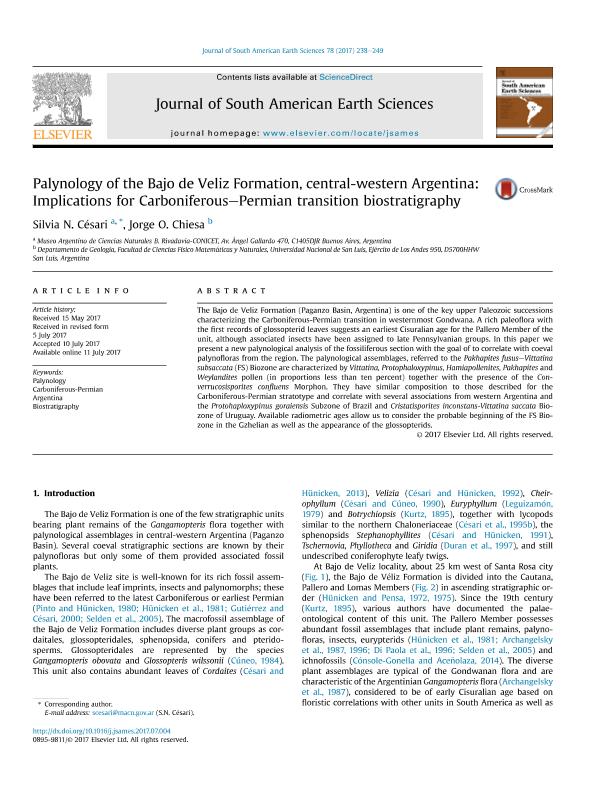Artículo
Palynology of the Bajo de Veliz Formation, central-western Argentina: Implications for Carboniferous–Permian transition biostratigraphy
Fecha de publicación:
11/07/2017
Editorial:
Pergamon-Elsevier Science Ltd
Revista:
Journal of South American Earth Sciences
ISSN:
0895-9811
Idioma:
Inglés
Tipo de recurso:
Artículo publicado
Clasificación temática:
Resumen
The Bajo de Veliz Formation (Paganzo Basin, Argentina) is one of the key upper Paleozoic successions characterizing the Carboniferous-Permian transition in westernmost Gondwana. A rich paleoflora with the first records of glossopterid leaves suggests an earliest Cisuralian age for the Pallero Member of the unit, although associated insects have been assigned to late Pennsylvanian groups. In this paper we present a new palynological analysis of the fossiliferous section with the goal of to correlate with coeval palynofloras from the region. The palynological assemblages, referred to the Pakhapites fusus?Vittatina subsaccata (FS) Biozone are characterized by Vittatina, Protophaloxypinus, Hamiapollenites, Pakhapites and Weylandites pollen (in proportions less than ten percent) together with the presence of the Converrucosisporites confluens Morphon. They have similar composition to those described for the Carboniferous-Permian stratotype and correlate with several associations from western Argentina and the Protohaploxypinus goraiensis Subzone of Brazil and Cristatisporites inconstans-Vittatina saccata Biozone of Uruguay. Available radiometric ages allow us to consider the probable beginning of the FS Biozone in the Gzhelian as well as the appearance of the glossopterids.
Palabras clave:
Argentina
,
Biostratigraphy
,
Carboniferous-Permian
,
Palynology
Archivos asociados
Licencia
Identificadores
Colecciones
Articulos(MACNBR)
Articulos de MUSEO ARG.DE CS.NAT "BERNARDINO RIVADAVIA"
Articulos de MUSEO ARG.DE CS.NAT "BERNARDINO RIVADAVIA"
Citación
Cesari, Silvia Nelida; Chiesa, Jorge Orlando; Palynology of the Bajo de Veliz Formation, central-western Argentina: Implications for Carboniferous–Permian transition biostratigraphy; Pergamon-Elsevier Science Ltd; Journal of South American Earth Sciences; 78; 11-7-2017; 238-249
Compartir
Altmétricas




